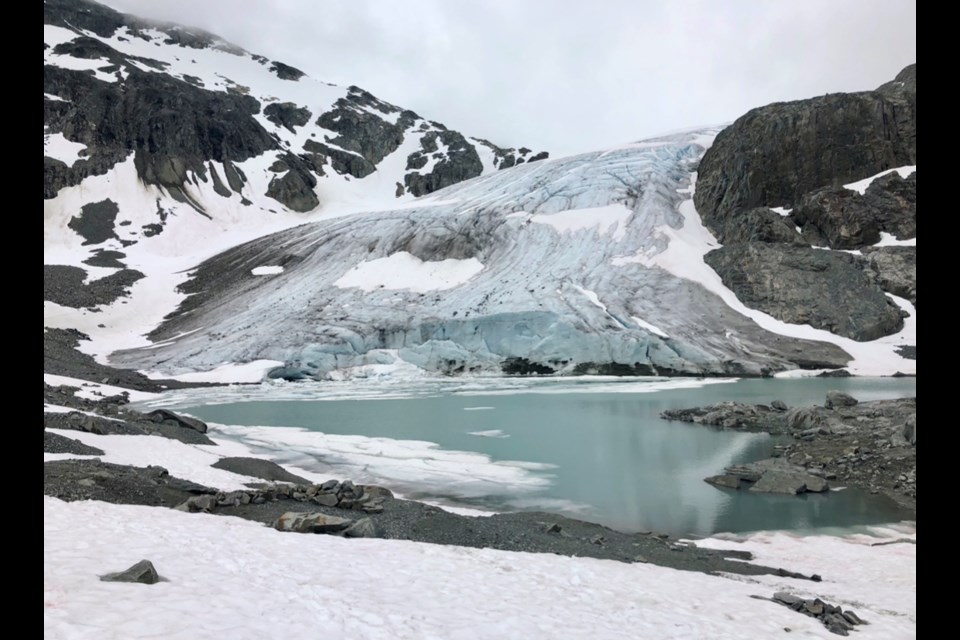Scrolling through the Whistler Summer Facebook group about a month ago (for work purposes, people), one post caught my attention.
Amid the endless stream of promotions, questions, recommendations, memes, complaints and for-sale posts was a photo of a glacier. Arguably, my favourite glacier, located at the top of one of my top-three favourite hikes in the corridor.
It was shot by Whistler photographer Kyle Graham, who posted it alongside another photo that, while similar, didn’t seem quite as familiar. Another socked-in, rocky alpine zone, another blue lake, another patch of rippled, layered ice. But this patch of ice was far smaller—almost as if it was shot from a kilometre further back. I stopped scrolling and looked closer. It was still Wedgemount Glacier, just a series of “before and after” shots taken five years apart.
The “after” image shows a glacier that’s almost entirely unrecognizable due to the sheer amount of ice missing.
It was heartbreaking. To me and to hundreds of others, judging by the number of people who interacted with the post.
The last time I hiked to the second lake (which I’ve since learned didn’t even exist a decade ago) was in the summer of 2019. Even armed with the knowledge that human-caused climate change is triggering the world’s ice to melt at startling rates, there’s something humbling about standing at the foot of thick ice walls in the middle of the summer, that have existed in the same location for thousands of years before I ever decided to lace up a pair of trail runners and walk uphill just to look at them.
It seems impossible for something so enduring to change so dramatically not over years, but in months—truly, a blip on the radar.
So I decided to ask a glaciologist about it, as well as a few citizen researchers whose families have been studying Wedgemount Glacier for generations, and write about it for Pique.
Thanks to researchers like University of Northern B.C. professor Brian Menounos, we know that between 2000 and 2019, the world’s glaciers lost on average 267 gigatonnes of ice per year, representing 21 per cent of the Earth’s observed sea-level rise in that time. That pace has only picked up in recent years, too, with Menounos and his colleagues recording a four-fold increase in rate of glacial melt within the last decade. According to a three-part series published by The Tyee earlier this year titled “The Big Melt,” that amounts to more ice lost annually than the total volume of water used in Canada each year. Countless studies and reports predict that the vast majority of B.C.’s glacial ice will be gone by the end of the century.
Even knowing these startling statistics, I was still secretly hoping that University of British Columbia glaciologist Michele Koppes would tell me that, while jarring, there’s still plenty of ice left, and with a few societal tweaks and lowered emissions we could reverse course.
That’s not exactly the message she had to share.
“If we were to be able to stop our behaviours, it would still take several hundred years to reverse the accumulation of greenhouse gases, particularly carbon dioxide, in the atmosphere,” she told me, adding that even in that case, there would be lasting impacts like dirt and particulates on the ice’s surface that can accelerate melting.
That means “it will be difficult to change our behaviours to such an extent that we can reverse the trend of ice loss,” she said.
The fact is, there are aspects of our planet—like glaciers that are disappearing before our eyes, or like the old-growth forest that’s already been chopped down—that will cease to exist within our lifetimes.
The idea of climate loss is no longer an abstract set of statistics or promised effects. There’s visible, tangible evidence all around us. Even still, we don’t yet know the full extent of how this loss will impact us. For example, how diminished glacier runoff later in the season could impact aquatic and coastal ecosystems down the line.
More trivially, these parts of our environment are also part of what drives tourism to Whistler and keeps this town functioning economically.
But beyond the obvious feelings of sadness and helplessness they stirred up, seeing those comparison photos of Wedgemount—or more accurately, being hit over the head with what’s been lost in just a single summer—made me feel grateful for the privilege of spending time in these disappearing places. When it comes to the environment, experiences like hiking through an old forest to an alpine glacier in July or snowboarding to an ice cave in February have sent my give-a-f*ck levels skyrocketing in a way no statistic ever could.
My hope is that while these places still exist, we appreciate them as much as we can, promote safe and responsible access to them, and, ideally, let that appreciation fuel a commitment to better protect whatever we still can.




